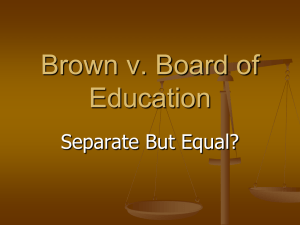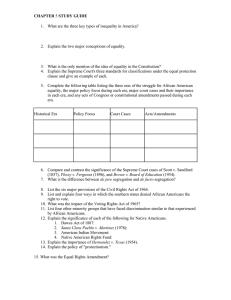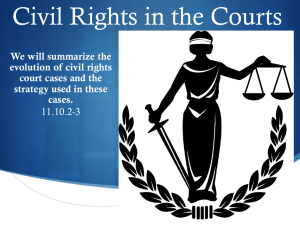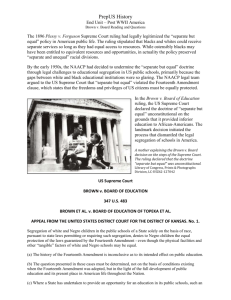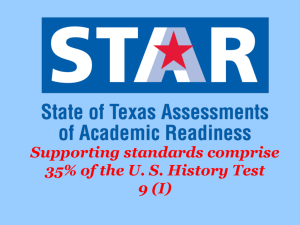Civil Rights Act of 1968
advertisement
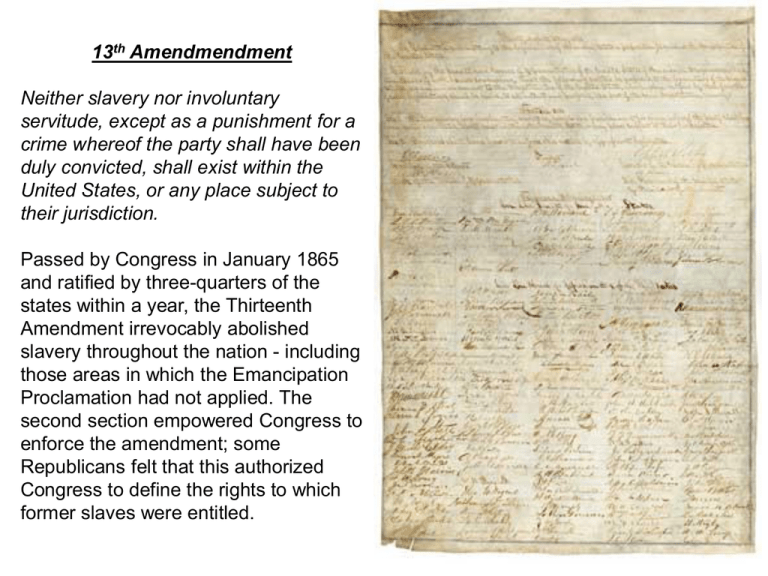
13th Amendmendment Neither slavery nor involuntary servitude, except as a punishment for a crime whereof the party shall have been duly convicted, shall exist within the United States, or any place subject to their jurisdiction. Passed by Congress in January 1865 and ratified by three-quarters of the states within a year, the Thirteenth Amendment irrevocably abolished slavery throughout the nation - including those areas in which the Emancipation Proclamation had not applied. The second section empowered Congress to enforce the amendment; some Republicans felt that this authorized Congress to define the rights to which former slaves were entitled. Amendment XV Section 1. The right of citizens of the United States to vote shall not be denied or abridged by the United States or by any state on account of race, color, or previous condition of servitude. Section 2. The Congress shall have power to enforce this article by appropriate legislation. The Enforcement Act of 1870 This Act was designed to protect black voters. Unfortunately, those who witnessed such violations were usually unwilling to testify so further legislation was soon necessary. There was a Second Enforcement Act in 1871(entitled everyone to full enjoyment of public accommodations ) and a Third Enforcement Act, also in 1871, which served the same basic purposes. This Third Act strengthened sanctions against those who impeded black suffrage. It gave the President the right to use federal forces to enforce the law. (These Acts were also known as the Ku Klux Klan Acts) Ku Klux Klan attacking black family inside their home. In 1883, The United States Supreme Court ruled that the Civil Rights act of 1875, forbidding discrimination in hotels, trains, and other public spaces, was unconstitutional and not authorized by the 13th or 14th Amendments of the Constitution. **NOTE**After 1875, Congress didn't pass another civil rights bill until 1957. 30-year-old Black shoemaker named Homer Plessy was jailed for sitting in the "White" car of the East Louisiana Railroad. Plessy was only one-eighths Black and seven-eighths white, but under Louisiana law, he was categorized Black and therefore required to sit in the "Colored" car. Plessy went to court and argued, in Homer Adolph Plessy v. The State of Louisiana, which the Separate Car Act violated the Thirteenth and Fourteenth Amendments to the Constitution. In 1896, the Supreme Court of the United States heard Plessy's case and found him guilty once again. The Plessy decision set the precedent that "separate" facilities for blacks and whites were constitutional as long as they were "equal." Brown v. Board of Education of Topeka (1954) U.S. Supreme court held that public school segregation of races violates the equal protection clause of the Fourteenth Amendment. After Brown v. Board of Education the Supreme Court essentially told lower federal courts that they had to take an activist role in society “With All Deliberate Speed” "School integration" Alex Wilson is kicked by a school integration protester after refusing to run from a mob near Little Rock Central High. De Facto Segregation - segregation because of previous conditions, not deliberate government intention. De Jure Segregation - racial segregation - that occurs because of laws or governmental decisions. During his signing of the landmark Civil Rights Act of 1964, President Lyndon B. Johnson shook hands with the Rev. Martin Luther King Jr. Equal Employment Opportunity Commission The EEOC was created by the Civil Rights Act of 1964 and can issue regulations, but they do not have the force of law Voting Rights Act of 1965 The Act eliminated discriminatory voter registration tests. As a result the number of African Americans registered to vote climbed dramatically Civil Rights Act of 1968 Followed shortly after King’s assassination and forbade discrimination in housing. Alice Paul Lucy Burns Congressional Union for Women Suffrage Betty Friedan’s The Feminine Mystique described the unequal status of women in the United States After the fight for the Equal Rights Amendment, various women’s groups addressed the issues of domestic violence, abortion rights, pornography, and state and national laws to guarantee the equality of women all of the following issues Concerning sexual harassment, the Supreme Court has ruled that sexual harassment can occur when words or actions of a sexual nature interfere with the employee’s work or create a “hostile environment.” Affirmative Action In the mid 1970's Allan Bakke, a white graduate student, protested his inability to enter medical school at the University of California at Davis. He arugued that affirmative action programs prevented him from entering and were denying him his rights under the 13th and 14th amendments of the Constitution. It was during the 1970's that there were protests of "reverse discrimination" or giving of preference to minorities over "whites" in many facets of life. The court case reached the Supreme Court and was settled by a split 5-4 decison in favor of Bakke. The court said racial quaotas must be eliminated but as Supreme court Justice Lewis Powell commented the " ..race can be a factor but only one of many to achieve a balance." In other words race could not be a decisive factor in admitting or excluding applicants. Affirmative action policies continued but was further defined. Adarand Constructors, Inc. v. Peña All racial classifications, imposed by whatever federal, state, or local government actor, must be analyzed by a reviewing court under a standard of "strict scrutiny," the highest level of Supreme Court review (such classifications are constitutional only if they are narrowly tailored measures that further compelling governmental interests). To pass strict scrutiny, the law or policy must satisfy three prongs: First, it must be justified by a compelling governmental interest. While the Courts hav never brightly defined how to determine if an interest is compelling, the concept general refers to something necessary or crucial, as opposed to something merely preferred. Examples include national security, preserving the lives of multiple individuals, and not violating explicit constitutional protections. Second, the law or policy must be narrowly tailored to achieve that goal or interest. If th government action encompasses too much (over-inclusive) or fails to address essentia aspects of the compelling interest (under-inclusive), then the rule is not considered narrowly tailored. Finally, the law or policy must be the least restrictive means for achieving that interes More accurately, there cannot be a less restrictive way to effectively achieve the compelling government interest, but the test will not fail just because there is another method that is equally the least restrictive. Some legal scholars consider this 'least restrictive means' requirement part of being narrowly tailored, though the Court general evaluates it as a separate prong. Adarand Constructors, Inc. v. Peña Affirmative Action Information Supreme Court Decision In a 5-4 opinion, the high court upheld the University of Michigan Law School's policy of reviewing each application individually and considering race along with a number of other factors. In a separate ruling, the court struck down the University of Michigan's policy of giving undergraduate minority applicants extra points toward admission because of their race. The Age Discrimination in Employment Act of 1967 The Americans with Disabilities Act (ADA) of 1990 Facts About the Americans with Disabilities Act Title I of the Americans with Disabilities Act of 1990, which took effect July 26, 1992, prohibits private employers, state and local governments, employment agencies and labor unions from discriminating against qualified individuals with disabilities in job application procedures, hiring, firing, advancement, compensation, job training, and other terms, conditions and privileges of employment. An individual with a disability is a person who: Has a physical or mental impairment that substantially limits one or more major life activities; Has a record of such an impairment; or Is regarded as having such an impairment. A qualified employee or applicant with a disability is an individual who, with or without reasonable accommodation, can perform the essential functions of the job in question. Reasonable accommodation may include, but is not limited to: Making existing facilities used by employees readily accessible to and usable by persons with disabilities. Job restructuring, modifying work schedules, reassignment to a vacant position; Acquiring or modifying equipment or devices, adjusting modifying examinations, training materials, or policies, and providing qualified readers or interpreters. An employer is required to make an accommodation to the known disability of a qualified applicant or employee if it would not impose an "undue hardship" on the operation of the employer's business. Undue hardship is defined as an action requiring significant difficulty or expense when considered in light of factors such as an employer's size, financial resources and the nature and structure of its operation. An employer is not required to lower quality or production standards to make an accommodation, nor is an employer obligated to provide personal use items such as glasses or hearing aids. MEDICAL EXAMINATIONS AND INQUIRIES Employers may not ask job applicants about the existence, nature or severity of a disability. Applicants may be asked about their ability to perform specific job functions. A job offer may be conditioned on the results of a medical examination, but only if the examination is required for all entering employees in similar jobs. Medical examinations of employees must be job related and consistent with the employer's business needs. DRUG AND ALCOHOL ABUSE Employees and applicants currently engaging in the illegal use of drugs are not covered by the ADA, when an employer acts on the basis of such use. Tests for illegal drugs are not subject to the ADA's restrictions on medical examinations. Employers may hold illegal drug users and alcoholics to the same performance standards as other employees. The Significance of the Stonewall Inn Lawrence v. Texas The Defense of Marriage Act of 1996
